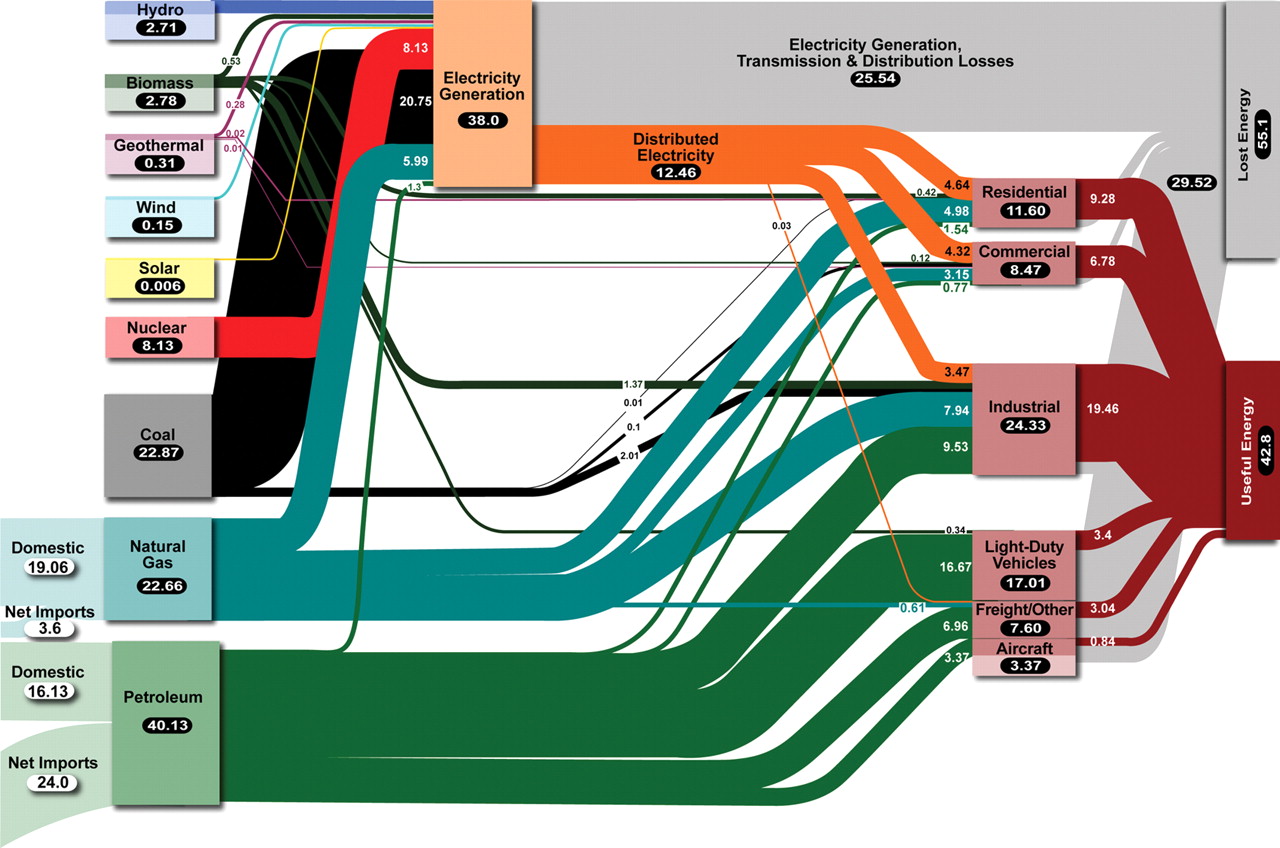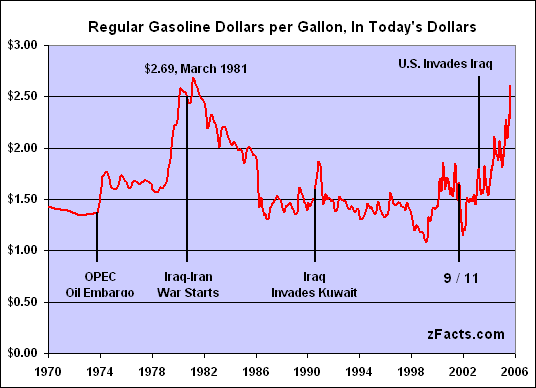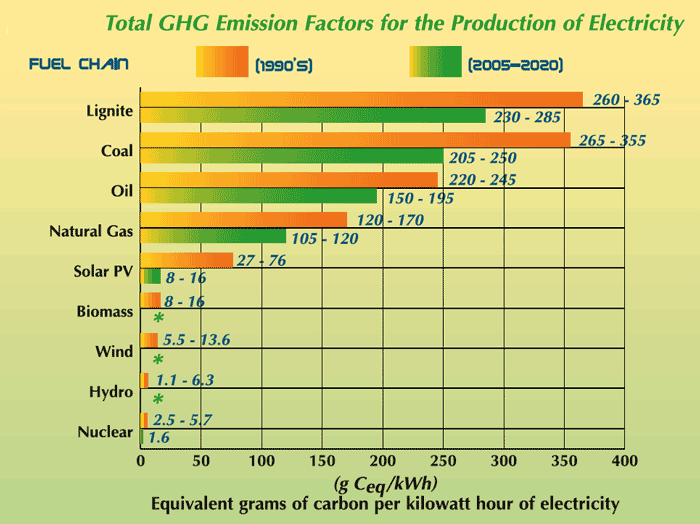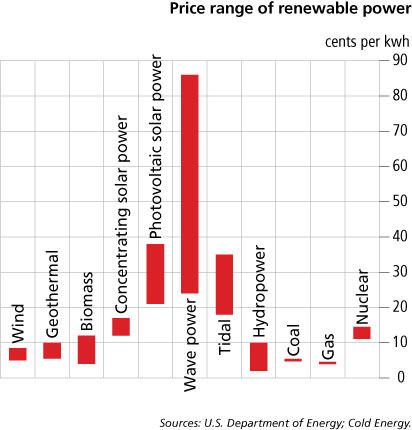
Energy
What is It?
In simple words, it is often said to be the ability to do work. It exists in many different forms, and it is measured with many different units. Some of the different forms are: heat; kinetic, potential, nuclear, chemical, mass, and electromagnetic. But the simple statement is way too simple. It is incomplete and wrong.
On a much deeper level,
There is a fact, or if you wish, a law, governing all natural phenomena that are known to date. There is no known exception to this law–it is exact so far as we know. The law is called the conservation of energy. It states that there is a certain quantity, which we call energy, that does not change in the manifold changes which nature undergoes. That is an abstract idea, because it is a mathematical principle; it says there is a numerical quantity which does not change when something happens. It is not a description of a mechanism, or anything concrete; it is just a strange fact that we can calculate some number and when we finish watching nature go through her tricks and calculate the number again, it is the same...
It is important to realize that in physics today, we have no knowledge of what energy is. We do not have a picture that energy comes in little blobs of a definite amount. It is not that way. However, there are formulas for calculating some numerical quantity, and when we add it all together it gives "28"—always the same number. It is an abstract thing in that it does not tell us the mechanism or the reason for the various formulas.
From Feynman, et al (page 4-1, 2006).
Carl Nave of Georgia State University has published a useful hypertext resource for Physics called HyperPhysics, especially his pages on energy.
Energy Units
Because energy is so important in so many different ways for so many different industries, many different units are used for energy.
- Joule is the scientific unit of energy. It is the work needed to push an object one meter with a force of one newton in the direction of the movement.
- Calorie is used to measure heat energy.
- It is the amount of heat needed to raise the temperature of one gram of water at 15 degrees celsius at a constant pressure of 101.325 kPa (1 atmosphere) by one degree celsius.
- 1 Calorie = 4.1855 Joules.
- The calorie used to measure the energy content of food is the kilocalorie = 1000 calories.
- Note, however, other, slightly different definitions of the calorie are used, ranging from 4.182 to 4.190 Joules/calorie. See the entry for Calorie in the Wikipedia.
- BTU is the British Thermal Unit, the English equivalent of the
calorie.
- It is the heat needed to raise the temperature of one pound of water at 39.1 degrees Fahrenheit by one degree Fahrenheit.
- 1 BTU = 1055 Joules.
- Note, however other, slightly different definitions of the BTU are used, ranging from 1054.3 to 1059.67 Joules/BTU. See the entry for BTU in the Wikipedia.
- 1 quad = 1015 BTU.
- One barrel of oil, when burned, releases about 5,800,000 BTU = 6,100,000,000 J = 6.1 Giga Joules = 6.1 GJ.
- One cubic foot of gas (natural gas), when burned, releases about 1,300 BTU = 1,400,000 J = 1.4 Mega Joules = 1.4 MJ.
- One ton (British) TNT = 4,184,000,000 J = 4.184 Giga Joules = 4.184 GJ.
Because energy values are often very large, we use the following prefixes for units in science. The letter in parentheses is the abbreviation for the prefix.
- kilo (k) = 103 = thousand
- Mega (M) = 106 = million
- Giga (G) = 109 = billion (US)
- Tera (T) = 1012 = trillion (US)
Sometimes called a billion (UK) - Peta (P) = 1015 = quadrillion (US).
- 1 quadrillion BTU = 1015 BTU = 1 Quad = 1.055 X 1018 Joules.
- 1 Quad ∼ 1018 Joules.
- Exa (E) = 1018
- Zeta (Z) = 1021
Why are we concerned about energy?
- Most of the energy we use in daily life is produced by burning
of fossil fuels.
- The energy is used by automobiles and to generate electricity.
- The burning releases CO2 into the atmosphere possibly causing global warming.
- We use so much energy that any source or sources will be so large that they will cause environmental problems. For example, windmills can be noisy and ugly, nuclear power plants produced long-lived radioactive waste.
How much energy do we use?
See the Statistical Review of World Energy 2005 by British Petroleum.
- Global energy use in 2003 was 4.1 X 1020 Joules which
is equivalent to 13 Terawatts.
- 1 Terawatt (TW) = 1012 Joules/second= 1012 Watts.
- The global energy use is equivalent to 71,000,000,000 barrels of oil equivalent used at the rate of 196,000,000 barrels of oil equivalent per day or the energy in 4.6 metric tons of mass converted into energy.
- Global energy use from fossil fuels was approximately 8,260 million metric tons oil equivalent, which is approximately 9,623 X 106 m3 = a cube of oil 2.12 km on a side.
- Global oil consumption in 2003 was 76,800,000 barrels of oil per
day.
- Most of the remainder of our energy comes from natural gas and coal.
- All are fossil fuels.
- The per capita consumption of energy in the United States is about
57 barrels of oil equivalent per year or 11 kW continuously.
- The energy is used to heat and light homes, offices, and stores, to power trucks and automobiles, and to operate machinery.
- 57 barrels of oil at $50/barrel = $2,850.
- If the energy were used entirely as electricity, it would cost about $7,300 per person per year.
- Consumption of energy in the United States was approximately:
- 39.1% oil
- 25.9% natural gas
- 24.4% coal
- 8.1% nuclear energy
- 2.5% hydroelectric, or
- 89.4% from fossil fuel consumption.
- The United States used approximately 24% of all the world's energy,
although we are only 4.6% of the world's population.

Pathways of energy use in the United States in 2005. More than half of the energy produced is wasted (gray paths). Click on image for a zoom. Units are in quads: 1 quad = 1015 British thermal units = 1.055 exajoules = 1.0055 × 1018 Joules.
From Whitesides (2007).
Why do we use so much fossil fuel?
We use fossil fuel because it is cheap relative to alternate sources of energy. Gasoline is cheaper than bottled water. Gasoline price in 2005 was just approaching the peak price of 1981.
From zFacts.
Price is determined by:
- Availability: Fossil fuels are abundant and easily extracted. The important question is: How long will they be abundant? The amount of known reserves divided by the rate of use has remained constant at around 40 years for more than 150 years. More recently, production has declined in many areas including the United States, Mexico, and western Europe. Many experts claimed world oil production has peaked and will begin to decline. This is known as Peak Oil. More recently they have been concerned with Peak Oil Demand, we may need less in the future than now as we switch to renewable energy sources.
- Economics: Supply relative to demand
is important.
- As supply drops and demand increases, price increases.
- Demand for oil is rising. The growth of the Chinese and Indian economies, and the increased use of oil by oil-exporting countries, has increased demand and reduced the supply of oil, driving up prices since 2005.
- If oil and gas become even scarcer in the next few decades, and if world demand continues to rise, the price will increases greatly. As a result, use will drop, and release of CO2 will drop, reducing the threat of global warming.
- Also, as prices rise, more sources are found, demand drops, conservation and efficient use increase, and alternate fuels are used. As a result, we never run out of a commodity.
- Politics: Political decisions and
laws have a strong influence on price:
- The Kyoto Protocol and the Paris Accord are political solutions to the CO2 problem, and if implemented, it will increase costs.
- Governments tax fossil fuels to raise revenues and to reduce consumption.
- Many governments own oil companies and use the revenue to help run their countries.
- Some governments limit the availability of fossil fuels.
- Some governments regulate the use of the fuels.
- In the United States, Congress mandated in 2005 that ethanol be used in all gasoline. Ethanol is expensive, and not readily available. This raised gasoline prices in 2006.
- In the United States, many local and state governments have not allowed the construction of oil refineries. This limited the availability of gasoline and drove up price.
Alternative Sources of Energy
To avoid the high cost of oil, and to reduce the emissions of greenhouse gases, governments are seeking alternate sources of energy. In the short term the outlook is bleak but not in the long term. Hoffert et al (2002) summarized the possibility of replacing fossil fuels with alternative sources of energy. Here is part of their abstract.
Here we survey possible future energy sources, evaluated for their capability to supply massive amounts of carbon emission-free energy and for their potential for large-scale commercialization. Possible candidates for primary energy sources include terrestrial solar and wind energy, solar power satellites, biomass, nuclear fission, nuclear fusion, fission-fusion hybrids, and fossil fuels from which carbon has been sequestered. Non-primary power technologies that could contribute to climate stabilization include efficiency improvements, hydrogen production, storage and transport, superconducting global electric grids, and geoengineering. All of these approaches currently have severe deficiencies that limit their ability to stabilize global climate. We conclude that a broad range of intensive research and development is urgently needed to produce technological options that can allow both climate stabilization and economic development.
From Hoffert (2002).
The important points made in the article are:
- "Energy sources that can produce 100 to 300% of present world power consumption without greenhouse emissions do not exist operationally or as pilot plants."
- Improved efficiency in use of fuels is possible, although many uses are already very efficient.
- "10 TW from biomass requires >10% of Earth's land surface, comparable to all of human agriculture." And, we are now using 12 TW, and we will use around 30 TW by mid century. Already, by 2008 the demand for biofuels collided with the demand for more and better food in developing countries leading to soaring food prices and food riots in many countries.
- "The electrical equivalent of 10 TW requires a surface array [of photocells] ~470 km on a side (220,000 km2). However, all the PV cells shipped from 1982 to 1998 would only cover ~3 km2"
- "The main problem with fission for climate stabilization is fuel...Current estimates of U in proven reserves and (ultimately recoverable) resources are 3.4 and 17 million metric tons, respectively ...At 10 TW, this would only last 6 to 30 years--hardly a basis for energy policy.
A second article by Pacala and Socolow (2004) noted "A portfolio of technologies now exists to meet the world's energy needs over the next 50 years and limit atmospheric CO2 to a trajectory that avoids a doubling of the preindustrial concentration..." Here is the abstract of their paper.
Humanity already possesses the fundamental scientific, technical, and industrial know-how to solve the carbon and climate problem for the next half-century. A portfolio of technologies now exists to meet the world's energy needs over the next 50 years and limit atmospheric CO2 to a trajectory that avoids a doubling of the preindustrial concentration. Every element in this portfolio has passed beyond the laboratory bench and demonstration project; many are already implemented somewhere at full industrial scale. Although no element is a credible candidate for doing the entire job (or even half the job) by itself, the portfolio as a whole is large enough that not every element has to be used.
From Pacala and Socolow (2004).
Still, even this will not be easy:
To put the stabilization challenge in stark terms, under Pacala and Socolow's most optimistic assumptions for stabilization at 550 p.p.m., the world will need to reduce its projected business-as-usual emissions by about 1,000 gigatonnes of carbon over the next century. Seven stabilization wedges worth would achieve 175 gigatonnes, leaving a considerable gap, even if the total business-as-usual emissions have been overestimated by a factor of two or more.
Many believe that if climate change can be dealt with relatively easily, then there would also be little need to adapt to it. This sort of thinking may explain why the issue of adaptation plays no role in the book. Overlooking adaptation in any discussion of climate policy is a sign that the challenge posed by climate change has been fundamentally mischaracterized — not only because the world is already committed to some degree of climate change, but also because adaptation makes sense under any future climate scenario.
From Pielke (2006).
In the words of Hardin in The Tragedy of the Commons, we must change our behavior to solve this problem,
One alternate source of energy that may be must useful for the next few decades may be nuclear fission, used by nuclear power plants. All power sources contribute to greenhouse gases, either directly through burning of fossil fuels, or indirectly through construction of facilities. But nuclear, wind, and hydro power contribute least.
Greenhouse gas (GHG) emissions from various power sources, including direct and indirect sources. * means projections are not available.
From Greening of the Nuclear Age by the American Nuclear Society, adapted from the International Atomic Energy Agency.
The cost of producing energy from alternative sources varies greatly, Nuclear energy is slightly more expensive than wind, geothermal, and biomass.
Price of energy from alternative sources compared with cost from fossil fuels.
From Forbes Magazine (24 November 2008: page 64).
We can reduce present fuel use by using more efficient systems such as mass transportation. But consider this editorial:
There are just two problems with mass transit [in the US in 2005]. Nobody uses it, and it costs like hell. Only 4% of Americans take public transportation to work. Even in cities they don't do it. Less than 25% of commuters in the New York metropolitan area use public transportation. Elsewhere it's far less -- 9.5% in San Francisco-Oakland-San Jose, 1.8% in Dallas-Fort Worth. As for total travel in urban parts of America -- all the comings and goings for work, school, shopping, etc. -- 1.7 % of those trips are made on mass transit. ... Heritage cites the Minneapolis "Hiawatha" light rail line, soon to be completed with $107 million from the transportation bill. Heritage estimates that the total expense for each ride on the Hiawatha will be $19. Commuting to work will cost $8,550 a year. If the commuter is earning minimum wage, this leaves about $1,000 a year for food, shelter and clothing. Or, if the city picks up the tab, it could have leased a BMW X-5 SUV for the commuter at about the same price. We don't want minimum-wage workers driving BMW X-5s. That's unfair. They're already poor, and now they're enemies of the environment?
From: O'Rourke (2005).
Historical experience since 1800 shows that increased energy efficiency usually leads to more energy consumption. Clearly, we have a long way to go to solve the problem of too many people driving cars.
Energy efficiency of freight transportation
This table summarizes the efficiency of the three main modes of transport of freight: by barge, rail, or truck.
| Barge | Rail | Truck | |
| Fuel Efficiency (1) | 514 miles | 202 miles | 59 miles |
| Barge Equivalents (2) | 1 barge | 15 cars | 58 trucks |
| Tow Equivalents (3) | 1 15-barge tow | 225 cars | 870 large semis |
| EMISSIONS RATIOS (4) | |||
| Hydrocarbons plus Nitrogen Oxides | 1.0 | 14.2 | 17.5 |
| Carbon Monoxide | 1.0 | 1.9 | 74.4 |
| Particulate Matter | 1.0 | 12.0 | 12.0 |
| (1) | These are
the miles one ton of cargo can be transported on one gallon of fuel. |
| (2) | One Mississippi barge
can transport 1,500 tons of cargo. This is equivalent to 52,500 bushels
of wheat or 453,600 gallons of fuel. |
| (3) | One tow, consisting
of a boat and fifteen barges is 0.25 miles in length, whereas 2.25 100 car
train units is 2.75 miles in length, and 870 trucks spaced bumper to bumper
is 11.5 miles in length. |
| (4) | Eastman Data
Emissions Comparison: This is the ratio of emissions for trucks and rail
on a ton-mile basis relative to barges. From Iowa Department of Transportation and and Tidewater |
References
Feynman, R., R. Leighton, et al. (2006). The Feynman Lectures on Physics, Addison Wesley.
Hoffert, M. I., K. Caldeira, G. Benford and many others (2002). "Advanced technology paths to global climate stability: energy for a greenhouse planet." Science 298 (5595): 981-987.
O'Rourke, P.J. (2005). Mass Transit Hysteria. Wall Street Journal, 16 March 2005, A24.
Pielke, R. A. (2006). What just ain't so. Nature 443 (7113): 753-754.
Pacala, S. and R. Socolow (2004). "Stabilization Wedges: Solving the Climate Problem for the Next 50 Years with Current Technologies." Science 305 (5686): 968-972.
Revised on: 29 May, 2017



